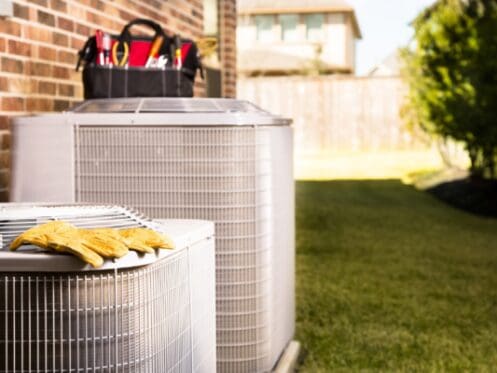If you’ve been thinking about replacing your air conditioner, furnace, or heat pump, there has never been a better time to do so. As part of the Inflation Reduction Act that was passed by Congress last year, the US federal government established several new programs that can allow you to save quite a bit of money on a new HVAC unit. The goal of these new programs is to ease the burden caused by inflation while also providing incentives to help all single-family homes improve their energy efficiency to help fight against climate change. Here is everything you need to know about these new rebate and tax incentive programs including what types of units qualify and how much you may be able to save.
2023 HVAC Tax Credits
The Inflation Reduction Act established new Section 25C tax credits as part of the Energy Efficient Home Improvement Tax Credit program. The program went into effect on January 1, 2023, and is set to run until the end of 2032, and it provides special tax credits for single-family homes that upgrade to a new high-efficiency air conditioner, gas furnace or heat pump. There are also tax credits available when you install a new biomass boiler or heat pump water heater as well as for improving your home’s energy efficiency through things like installing new ENERGY STAR doors and windows, increasing your home’s insulation, or having a home energy audit performed.
Under the new program, you can potentially qualify for a credit of up to $3,200 per year. However, there are specific energy-efficiency requirements, and all tax credits are capped at a maximum of 30% of the total purchase and installation cost for each new unit.
The program is split into two separate credits worth up to $1,200 and $2,000. Installing a new furnace or air conditioner or improving your home’s energy efficiency falls into the first $1,200 category, whereas installing heat pumps, biomass boilers and heat pump water heaters is in the second $2,000 category.
If you install a new gas furnace or air conditioner, you can qualify for a tax credit worth up to $600 per unit. If you were to replace both in the same year, you would then be eligible for a total amount worth up to $1,200. Upgrading your windows and doors can also earn you a credit of up to $600 per year. However, it is important to note that you can still only get a maximum of $1,200 per year for all these things combined. A new heat pump can qualify for the total credit of up to $2,000 a year and is not included in the same category as the other upgrades.
To qualify, all new units must meet specific requirements. The unit must be ENERGY STAR-certified and have at least a certain energy-efficiency rating. The minimum ratings required to qualify are for this year only and are almost certain to continually increase over the next few years. The reason is that the wording of the law states that the units must meet all requirements to qualify for the current year’s highest efficiency tier as determined by the Consortium on Energy Efficiency, and these requirements are updated at the start of every year. In more basic terms, it means that a unit that qualifies for a tax credit this year may not qualify next year if the requirements for the highest efficiency tier change.
For 2023, the requirements for each type of unit are as follows.
- Central air conditioners: 17 SEER2
- Electric heat pumps: 18 SEER2 and 10 HSPF2
- Gas furnaces: 97% AFUE
The new program also established retroactive tax credits for anyone who had a qualifying air conditioner, furnace, or heat pump installed in 2022. This retroactive tax credit has the same minimum energy efficiency requirements and is capped at a maximum of $500.
New HVAC Rebates
In addition to the new tax credit program, the Inflation Reduction Act also created the new High-Efficiency Electric Home Rebate Program that will be administered by the state government. The federal government has earmarked $4.4 billion for this program which is being distributed between the states based on population. Each state must run its own program and distribute the rebates so the timeline of when the rebates will be available may vary. Most states should start distributing the rebates later this year or sometime in 2024, and the program will then continue to run until the state has distributed all its funds.
The rebate program is mainly for new electric heat pumps, but you can also qualify for purchasing an electric induction stove or heat pump clothes dryer and for improving your home’s energy efficiency or upgrading your electrical system. The great thing is that you should get this rebate a few weeks after you apply instead of having to wait until you file your taxes. The rebates and the tax credit also stack, which means you can qualify for both on the same unit. However, the rebates are only available if your yearly household income is no more than 150% of the median income in your area.
If your household income is under 80% of the median income in your area, you can qualify for rebates of up to $14,000 per year. Households with an annual income between 80 and 150% of the median income can qualify for a rebate worth up to $7,000 a year.
All new electric heat pumps can qualify for a rebate of up to $8,000 or $4,000 depending on income level. Unlike the tax credit, all heat pumps qualify as there are no specific energy efficiency requirements. Families that meet the low-income requirements qualify for a rebate worth 100% of the total cost of having the new heat pump installed up to $8,000. Moderate-income families can get a rebate of up to 50% of the total cost of the installation worth up to $4,000.
There are also additional rebates worth up to $6,000 or $3,000 per year for home energy audits, home electrification projects, and energy efficiency improvements. Each of these other improvements falls into a separate category and the rebates are only available for projects that meet specific requirements.
This rebate program is fantastic as it means you may be able to get most, if not all, of the cost of your new heat pump back. When combined with the tax credit, you may even end up making a bit of money depending on your income level and the cost of your new heat pump. However, the fact that each state only has a limited amount of funds to distribute means you will want to act fast as the money will likely run out quite quickly in some states.
At First Choice Plumbing, Heating & Air Conditioning, we can help you choose a new HVAC unit that qualifies for the tax credit and rebate programs and ensure that it is installed properly and according to all relevant local building codes. We are proud to be a Rheem Pro Partner, and we carry a variety of different units that meet the requirements for these new programs. We can also assist with any heating and cooling repairs and maintenance needs or if you need any plumbing services in the Metuchen area. For more information on the new tax credits and rebates, give us a call today.




